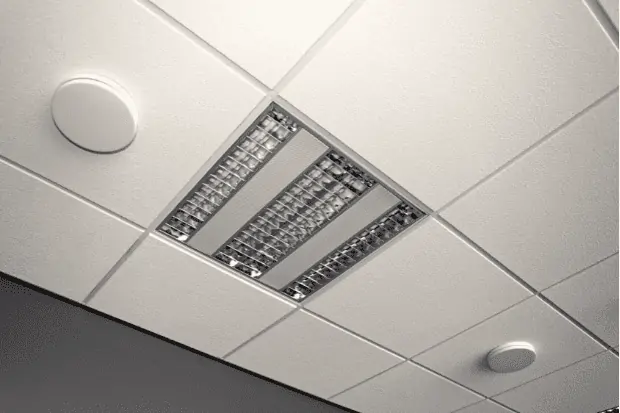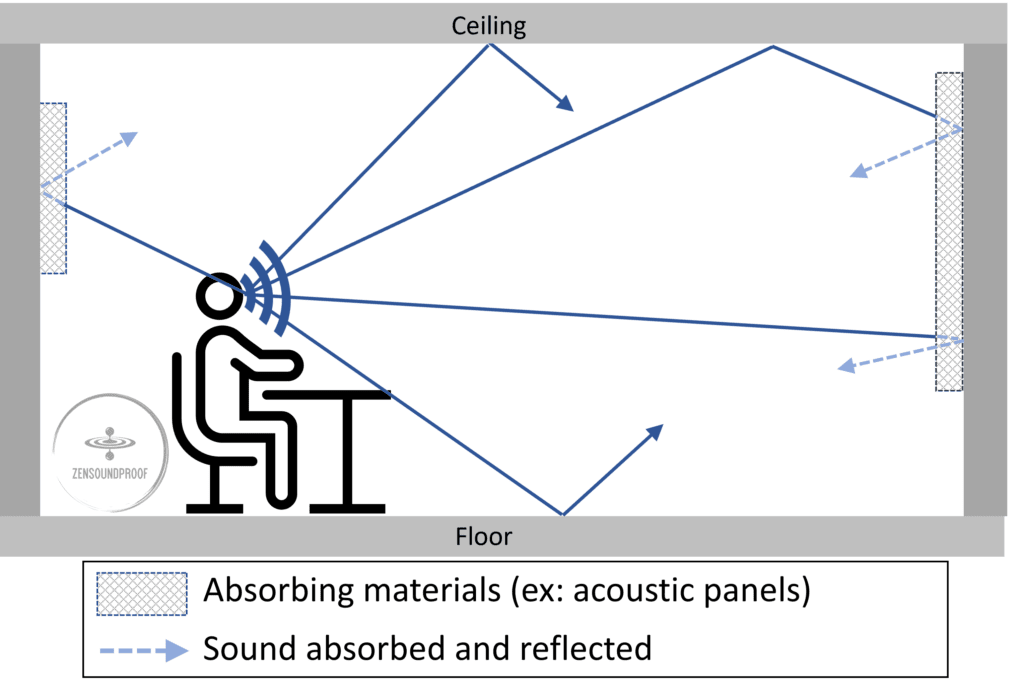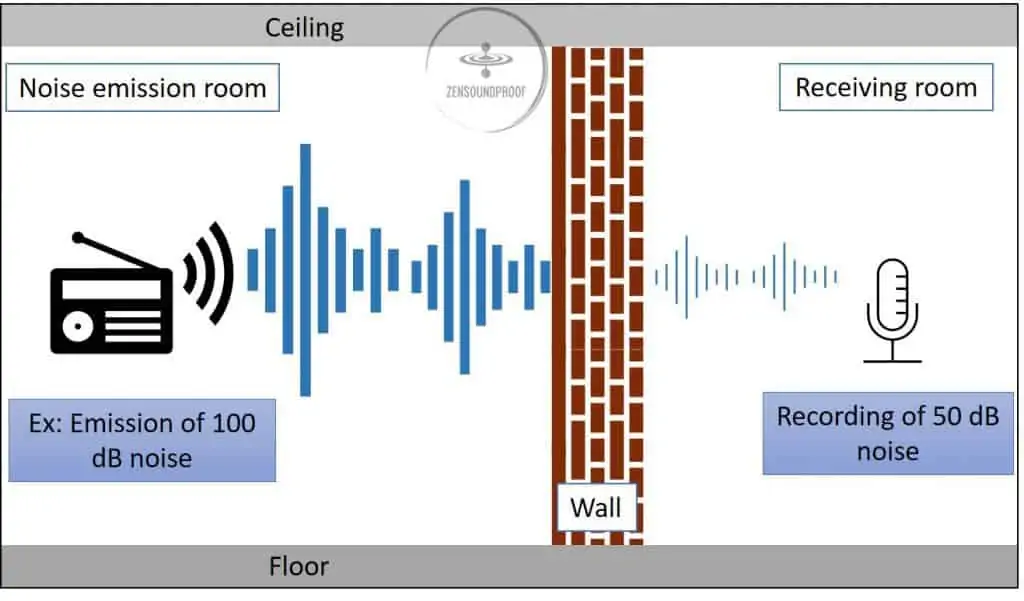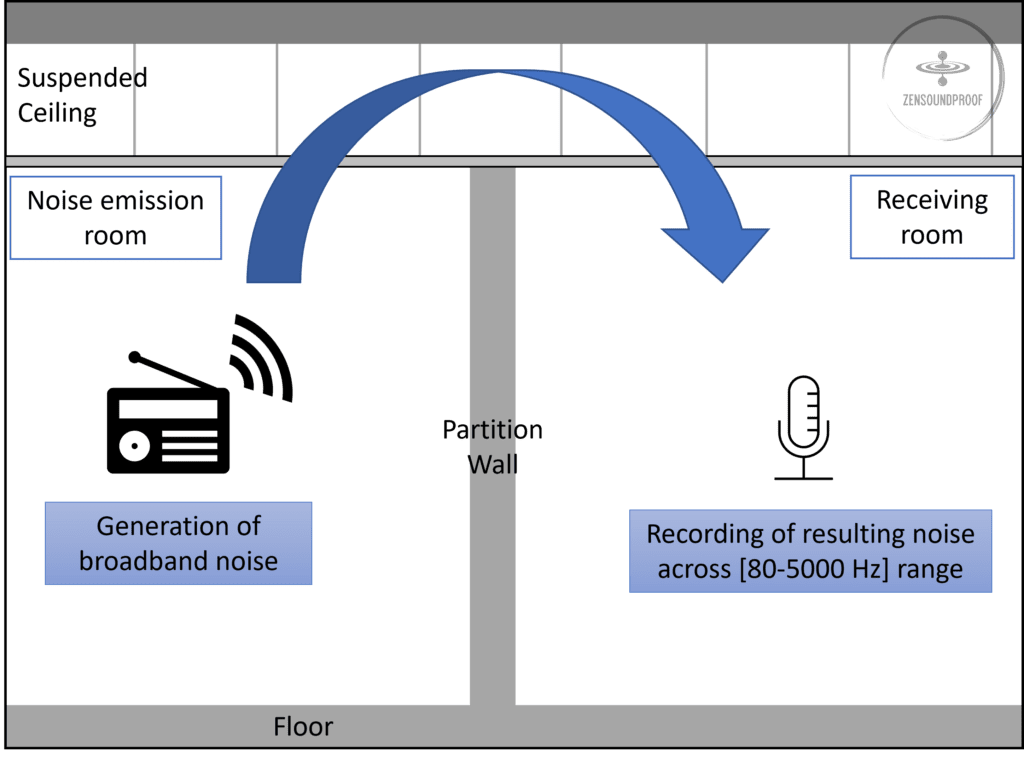For those in a hurry, my personal favorite as the best soundproofing ceiling tiles goes to the Armstrong Ultima (see review).
Soundproof ceiling tiles are an often-overlooked component of the soundproofing process. After all, there’s no point in soundproofing walls and floors if you then ignore the room’s hollow suspended ceiling.
In this article, I review my top picks for the best acoustic ceiling tiles. First, let’s go over how they work, and with what type of ceiling setup.
What Type of Ceiling do You Have?
There are 2 main types of ceiling setup in residential and commercial buildings. You’ll either have a drywall ceiling or a suspended (dropped) ceiling. We won’t discuss drywall ceilings here, but you can find solutions such as installing drywall over resilient channels and sound clips. For that, check my guide on how to soundproof a ceiling.
Suspended Ceilings
Suspended ceilings are separate from a room’s main ceiling. As the name implies, tiles (often polystyrene or similar) get suspended from a grid of metal channels, shaped like upside-down Ts. This is why you might hear them referred to as “T-channel ceilings”.

Suspended ceilings are what we’ll focus on here because they are where we can install soundproof ceiling tiles. Large voids above dropped ceilings can be perfect echo chambers for airborne sounds, hence why acoustic ceiling tiles are a good idea.
How do Acoustic Ceiling Tiles Work?
Acoustic tiles work by absorbing sound waves. This is the soundproofing principle of absorption, which reduces reverberation in a room. As I discuss elsewhere, this isn’t the same as soundproofing, despite the product sometimes being called soundproof tiles.
The tiles have an open-celled structure, which traps airborne sound waves that bounce off hard surfaces. They typically use mineral fiber – the structure allows sound waves to enter but not leave, as they expend their energy bouncing off its multiple surfaces. It results in the vibrational energy converting to heat energy.
Acoustic tiles won’t provide sound blocking from one side of the ceiling to another. Given their nature, acoustic tiles will only absorb and muffle incoming noises.
Sound Absorption is only one of 4 main soundproofing principles. The others are mass, decoupling and damping. For best results in any soundproofing project, you’ll want to use as many principles as possible.
Your best shot for blocking noise is giving up on drop ceilings and installing a denser material, like drywall, decoupled from your ceiling joists with sound isolators, as illustrated here.
So, it’s worth noting that soundproof ceiling panels won’t do much on their own.
They’ll mainly mitigate reverberation and muffle incoming sounds. Don’t expect them to block noise as they’re not dense nor stiff enough to do so. You’ll want to use tiles alongside things like adding mass to the walls, damping materials, and even wall decoupling.
How to Measure Soundproofing Tiles Efficiency
Luckily for us, there are plenty of different ways to measure the effectiveness of soundproofing products. We’ll go over the 3 most relevant to acoustical tiles, which are NRC, STC, and CAC.
Noise Reduction Coefficient (NRC)
NRC stands for Noise Reduction Coefficient. It measures the sound absorption performance of a material on a scale of 0.0 to 1.0.
0 means the material reflects sound, while 1 means it absorbs 100% of the airborne sound, thereby reflecting none of it back into the room (reverberation).

Measurements are taken in a lab according to ASTM C423. A ceiling with an NRC under 0.5 is considered poor, while an NRC above 0.7 is considered good for managing reverberation.
Sound Transmission Class (STC)
STC stands for Sound Transmission Class and measures how much a material reduces airborne noise being transmitted through it. Again, it’s tested in a lab, where instruments measure the sound loss in decibels on both sides of the material.

STC alone can be unrepresentative of a material’s noise-reducing ability. For example, a wall might have a great STC rating but does very little to reduce low-frequency noises. As such, we’re best using it alongside other measurements and understanding more about the material we’re looking at.
Ceiling Attenuation Class (CAS)
CAC is Ceiling Attenuation Class and, unsurprisingly, measures attenuation in ceiling tiles. It’s an STC rating specifically for ceilings. We have a separate measurement for ceilings because it takes into consideration 2 rooms sharing a common ceiling.
For example, 2 rooms in an office have a partitioning wall and a dropped ceiling, which has a void above it. The wall doesn’t extend into the ceiling void, so the tiles are what’s stopping sound transmission from one room to the adjacent room. To measure this, we would use CAC.

CAC gets tested using ASTM E1414. It sounds fancy, but it’s essentially the process I described in the previous paragraph. Of course, the lab experiment is much more controlled than the scenario I described. All we need to take away from this is that a higher CAC rating means better sound attenuation in a ceiling tile.
A ceiling with a CAC rating below 25 is considered poor, while any CAC rating above 35 is considered performant against airborne transmission.
Our Top 5 Picks
My reviews below are for acoustical ceiling panels for soundproofing drop ceilings. As I mentioned, you can find soundproofing options for drywall ceilings in my other article. For these reviews, I mention CAC ratings where possible, as these are arguably the best measure of a tile’s sound absorbing properties.
1. Top Pick: Armstrong Ultima Ceiling Tiles
- Size: 24″ x 24″
- Thickness: 0.75″
- Material: Mineral fiber
- NRC: 0.75
- CAC: 35
These ceiling tiles from Armstrong have a CAC rating of 35 and an NRC rating of 0.75. As such, we can consider them to be high-performance acoustic ceiling panels.
They have a smooth texture without any direction in the pattern. It’s a minor feature, but it means you don’t have to spend ages matching anything during the installation process. Perhaps a more important feature is that the tiles are mold and mildew resistant and can be washed.
Speaking of, they’re super easy to install. They fit standard 15/16” or 9/16” T-bar ceiling setups, and you don’t need any glue or staples to fit them. You simply remove the old tiles and drop the new ones in place.
These tiles use mineral fiber (similar to mineral wool insulation) as their sound-absorbing material. It’s then sandwiched together (similar to drywall) and painted white. Each tile has a tegular edge, meaning there’s a small section cut out to make installation easier.
The only real downside – and it’s a minor one – is that you get 12 in a pack. While this will be fine for residential uses, replacing an entire office ceiling with them will get expensive fast. However, it’s a standard pack size for ceiling tiles and is the price you pay for acoustical performance.
- CAC of 35.
- Easy to install and cut.
- Fits most standard suspended ceilings.
- Fitting in a large ceiling will get expensive.
2. Top Pick for Home: Soundsulate Acoustical Drop Ceiling Tiles
- Size: [24″ x 24″] or [24″ x 48″]
- Thickness: 1″ or 2″
- Material: Fiberglass with fabric
- NRC: 0.70
- CAC: NC
The main reason I’ve selected these Soundsulate tiles as my top pick for homes is that they’re black. It might sound like a minor point, but if you’re building a recording studio or home theater, the last thing you want is white ceiling tiles!
Of course, they perform fairly well, too. They have an NRC rating of 0.7, putting them just behind the Armstrong tiles. Unfortunately, there isn’t a CAC rating, but previous users regularly state they do the job well in home theaters and sound studios.
These tiles use fiberglass sandwiched between fabric, so aren’t as rigid as other ceiling tiles. Also, you’ll need to wear protection if you plan to cut them because fiberglass can be a horrible product to work with.
The standard pack size is 10 tiles measuring 24” square. They’re 1” thick, but again this is because of the fiberglass layer. While you might not want to install these tiles in an office because of their look, they should work fine for residential applications.
While acoustically-wise, they work fine, the only real downside is that they’re not really ceiling panels. It’s fairer to call them insulation tiles that you fit in a ceiling. However, it’s not an issue in itself, as either way you can install them in a suspended ceiling frame.
- Black cover makes them ideal for home theaters.
- NRC rating of 0.7.
- Will cover a large area.
- Fiberglass is difficult to work with.
3. Armstrong Cortega Ceiling Tiles
- Size: 24″ x 24″
- Thickness: 0.625″
- Material: Mineral fiber
- NRC: 0.55
- CAC: 33
Much like my top pick above, these Armstrong ceiling tiles have pretty decent stats. The CAC rating is 33 and the NRC rating is 0.55. So, they’re not as good, but this is because they’re thinner tiles. Importantly, though, they’re also cheaper.
You get 16 tiles in a pack, which covers 64 sq. ft. They’d be a budget-friendly solution for offices because you could cover a larger area than with the Ultima tiles and still get decent noise reduction.
They have a fissured texture that some might not like. It doesn’t have an impact on performance; it’s purely about looks. However, in commercial buildings, few people probably care about the ceiling’s texture!
As with the Ultima tiles, they use mineral fiber and fit standard drop ceiling frames. You can install them without glue or staples, and they’re easy to cut. Unlike the Soundsulate tiles, you won’t end up with fiber residue everywhere.
The only vaguely negative thing to say about these tiles is the damage they can do to your cutting device. One reviewer mentioned that they wore down a circular saw blade installing the tiles. So, I recommend buying a box of craft knife blades and simply throwing them away after a few cuts.
- CAC of 33.
- More budget-friendly than the Ultima tiles.
- Easy to install.
- Fissured texture isn’t to everyone’s taste.
4. Ceilume Acoustical Ceiling Tiles
- Size: [24″ x 24″] or [24″ x 48″]
- Thickness: 0.51″
- Material: Vinyl
- NRC: 0.25
- CAC: 14
With a CAC rating of 14, these tiles from Ceilume aren’t as good as the Armstrong tiles above. That said, they’ll be better than standard ceiling tiles, so will be worthwhile if you’re on a budget.
Part of this is because they use vinyl rather than mineral fiber. Generally, vinyl falls under the soundproofing principle of mass, but a 0.013” sheet of vinyl in a ceiling tile can’t really be considered high mass! Also, due to the material, the products NRC and STC ratings are 0.25 and 10, respectively.
However, these soundproof ceiling tiles have 2 potential advantages over the Armstrong ones. First, they have a peak and valley design. While this won’t do much for performance, it at least looks a bit more interesting than standard flat ceiling tiles.
Second, you get 14 tiles in a pack, which cover 56 sq. ft. So, if you need to cover a large area and want a bit of extra noise-reduction, these might still be a good choice. Somewhere like a quiet office, you might find they do enough.
Some reviewers state that they feel a bit flimsy, but this shouldn’t matter too much once they’re installed in a suspended ceiling. Others appreciate that there’s no mineral fiber residue from cutting and installing, though, and this is definitely another big advantage.
- Use vinyl instead of mineral fiber.
- 14 in a pack – cover a bigger area.
- More interesting design than other ceiling tiles.
- Performance isn’t great compared to Armstrong’s lineup.
5. Armstrong Dune Ceiling Tiles
- Size: 24″ x 24″
- Thickness: 0.625″
- Material: Mineral fiber
- NRC: 0.50
- CAC: 35
This list might seem dominated by Armstrong tiles, but it’s because they make a good product! These ones are no exception and strike a good middle ground between the Ultima and Cortega.
They have a CAC rating of 35 (same as the Ultima) and an NRC of 0.5 (slightly lower than the Cortega). You get the same number in a pack as the Cortega, meaning they cover the same area.
Other than performance, the biggest difference is the texture. Rather than being fissured, they’re textured like standard drop ceiling tiles. As such, it’d be really easy to match them into existing ceiling tiles if you need to.
Again, installation and fits are the same as the other models. They feature HumiGuard, which gives them mold and mildew resistance. The only real downside is that, like the Cortega tiles, these will blunt your cutting instrument quickly.
- Good middle ground between other Armstrong options.
- CAC rating of 35.
- Less expensive than Ultima tiles.
- Will blunt your cutting instrument.
What to Look for
By now, it should be fairly obvious what to look for in acoustic ceiling tiles. However, I’ll cover the most important points below so you can narrow your search for the best product.
Purpose
On the surface, the purpose of an acoustic ceiling tile might be clear: to reduce noise. But it’s more about how you want to reduce the noise and what your overall goal is.
For example, you might want to reduce echo in a room. This would more likely be the case somewhere like a recording studio or open-plan office. Reducing echo requires ceiling tiles designed to absorb sound waves bouncing around the room.
On the other hand, you might want to block noise from entering the ceiling void. This would usually be the case in 2 contained but adjoining offices, or perhaps in a home theater setup.
As I mentioned above, most ceiling tiles will absorb sound. However, those with a high CAC rating could move more into blocking than absorption, as they reduce the level of noise entering the ceiling cavity and, by extension, transmitting elsewhere in the building.
Noise Ratings
When looking at ceiling tiles, we’ll mainly use NRC and CAC. STC ratings exist, but CAC is the ceiling equivalent of these. The actual ratings you look for will be relative to your overall goals.
That said, I wouldn’t bother looking at an NRC rating of less than 0.5. It’s the middle of the scale, and any soundproofing product with a lower rating won’t do a very good job.
CAC ratings follow a similar logic. It ultimately depends on your goals, but anything above 30 is considered a high-performance product for ceiling attenuation. All the Armstrong tiles have CAC ratings higher than 30, meaning they’re decent products.
Installation
Generally, installing acoustical ceiling tiles isn’t a difficult job. If you’re just replacing existing tiles, all you should need to do is fit them in place. There’s typically no need for glue or staples, providing you already have the T-bar support frame.
Of course, if you’re attaching them directly to a drywall ceiling, it’s a different job. In this case, you’d want to use glue and even some acoustic caulk (such as Green Glue).
The other thing to watch out for is cutting tiles to size for the border of your ceiling. If they contain fiberglass, wear PPE. Some tiles use mineral fiber, which is the essentially same thing but more compacted. For these, you’ll want a disposable cutting instrument because they’ll blunt it pretty fast.
Coverage
The standard size for a ceiling tile is 2ft. square (or 24” x 24”). You can get rectangular tiles, but these are less common. If you already have the T-bar system in place, it should be obvious which you need.
Coverage is measured in square feet, and most packs will state their overall coverage. To work this out, you could calculate the area of your ceiling or simply count the number of tiles it holds.
Price
You won’t find a quality product for less than $100 a pack. I could say this is due to high-performance materials, but it’s more down to it being a small market. This leads to manufacturers simply setting whatever price they want, as people will have to pay it.
However, if you’re setting up a soundproof or low-noise space, you probably already know it won’t be a cheap project.
Final Thoughts
I hope you’ve now got a better idea of what to look for in soundproof ceiling tiles.
My top recommendation is the Armstrong Ultima tiles, as their performance is pretty great. That said, any of the Armstrong products I’ve listed will do a good job.
Do you have experience fitting and working with acoustic ceiling tiles? If so, I’d love to hear from you in the comments!






1 thought on “5 Best Soundproof Ceiling Tiles: For Acoustical, Residential, and Commercial Use”
You might consider CertainTeed’s Theater Black ceiling tiles. They have excellent NRC, a great matte black face that doesn’t attract dust and are considerably cheaper and easier to cut than the Soundsulate as they have a more rigid fiberglass core.